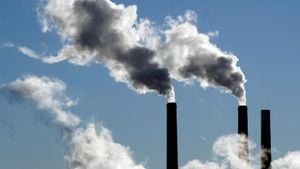Delhi is grappling with one of its worst air pollution crises yet, as the city’s Air Quality Index (AQI) soared to alarming heights, consistently exceeding levels deemed hazardous. The fallout has prompted substantial government responses, echoing calls for immediate action as the toxicity of the air poses severe health risks for residents.
On November 18, 2024, the AQI hit staggering levels, reportedly reaching 755, effectively making it equivalent to smoking 49 cigarettes every day, according to sources monitoring air quality. With residents struggling to breathe and visibility drastically reduced, it’s no wonder the Supreme Court has intervened, not mincing words about the necessity for action.
The Supreme Court issued directives maintaining stringent measures under the Graded Response Action Plan (GRAP), particularly Stage IV, indicating the seriousness of the situation. Justice A. S. Oka and Justice A. G. Masih firmly stated, “We make it clear till any orders are passed by the court, implementation of GRAP Stage IV will continue even if AQI readings fall below 450.”The Bench didn't shy from criticizing the delay of measures, indicating their discontent with the slower response from the Commission for Air Quality Management (CAQM).
Among the immediate measures taken under Stage IV were the suspension of various construction and demolition activities, which are known to generate dust and worsen the air quality. The entry of trucks—except those carrying essentials—was banned, and light commercial vehicles were restricted from entering the city. These measures collectively aimed to curb the pollution influx and provide immediate relief for the population.
Adding to the urgency, physical classes for students from Class 10 to Class 12 have moved online, with state governments taking rapid steps to comply with the Supreme Court’s directives. Authorities are now scrambling to keep young learners safe from the choking smog engulfing Delhi and the neighboring regions, including Gurugram.
Delhi Chief Minister Atishi responded vocally at this juncture, attributing the crisis partly to the widespread stubble burning occurring across several neighboring states. She criticized the central government, alleging negligence and failure to act. Atishi asked, “What is the Centre doing? Why is Prime Minister Modi silent?” The push for accountability reflects the discontent among residents who are grappling with the consequences of poor air quality and governmental inertia.
According to Atishi's remarks during interviews, the rampant stubble burning practices have drastically worsened the air situation, exacerbated by climatic conditions. She emphasized the need for collaboration across states to tackle the multi-faceted problem, noting, “Stubble burning does not happen solely within Delhi's borders, and immediate action must be broad-based.”
The CAQM’s report indicated the number of days under severe pollution continues to rise annually, sparking debates on long-term solutions and more stringent regulations. Critics point to the need for systemic changes rather than just responses to immediate crises, arguing these high pollution levels have become cyclical, particularly during the winter season.
Residents aren’t waiting to be told what to do; many have adapted by wearing protective masks and limiting outdoor activity. Local authorities have urged people to remain indoors whenever possible, offering online platforms for education and even yoga classes to promote safety and well-being during these hazardous times. Schools have been particularly responsive, quickly transitioning classes to virtual platforms, reflecting the adaptation of educational frameworks amid physical challenges.
Transportation has also been affected, with over 160 flights canceled or delayed due to thick smog blurring visibility at Indira Gandhi International Airport. Train services took hits too, with reports indicating significant delays across numerous routes—one train was reportedly held up for impressive nine hours.
Health specialists are voicing alarms about the impact on long-term respiratory health, especially for children and those with pre-existing conditions. Many hospitals have reported increases in respiratory cases, leading to calls for immediate health interventions and access to resources for those most vulnerable.
Earlier this month, before the drastic escalation, AQI readings moved beyond the 400-mark, triggering the initial responses under Stage III; this included more incremental measures aimed at reducing vehicular emissions and ceasing construction. But it was only recently—as the air quality dropped to severe levels—that stricter Stage IV measures were enforced.
The Supreme Court noted with concern the pattern of delayed responses from the CAQM, stating, “The approach adopted by the Commission seems to be one of waiting for improvements rather than taking preemptive actions.” They had mandated proactive measures to prevent what has become a recurring crisis for the region during the winter months.
The interplay of local agricultural practices, industrial emissions, and atmospheric conditions is now under scrutiny as policy recommendations take root. Experts insist on creating more stringent regulations for emissions and examining cross-border pollution impacts, emphasizing collective action for resolutions.
At this point, it is not merely about implementing plans but about sustaining action perennially. “We need to integrate environmental accountability within our development frameworks,” highlighted one environmental scientist, urging the authorities to rethink standard operating procedures to build resilience against future pollution crises.
The Delhi air quality crisis sheds light on the wider issue of urban pollution across India, urging citizens and the government alike to reconsider their approaches down to daily business practices. With the bleak condition persisting, the need to balance development and environmental sustainability has never been more pressing.
While immediate responses create some temporary relief, the overarching challenge lies within creating lasting change. The citizenry and leaders must bridge the gap between policy and practice, threading proactive environmental stewardship with industrial growth and infrastructural improvements, transforming the potential crisis management paradigm to one of prevention and sustainability.”



